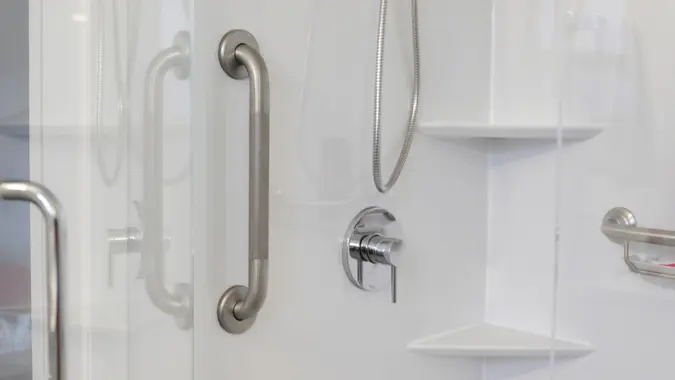Retirement Planning: Here’s How Much You’ll Need To Save If You Live to 100

Commitment to Our Readers
GOBankingRates' editorial team is committed to bringing you unbiased reviews and information. We use data-driven methodologies to evaluate financial products and services - our reviews and ratings are not influenced by advertisers. You can read more about our editorial guidelines and our products and services review methodology.

20 Years
Helping You Live Richer

Reviewed
by Experts

Trusted by
Millions of Readers
Living a long healthy live should be the ultimate goal for any American, but when it comes to approaching retirement costs, how long you live will affect how much money you’ll need.
One in every two five-year-olds alive today will now live to see 100, according to researchers at Stanford University’s Center on Longevity. If you’re in that majority that plans to surpass the average American’s life expectancy of 77 years and live to be 100, you’ll need to prepare for it.
The United Nations calls this a “longevity revolution,” and Time noted that it will challenge everything we thought we knew about healthcare, personal finance, retirement, politics and more. It’s not just about retiring early at age 50 or even age 62; it’s about how much money it will cost you to retire for 20 or 30 years, and if you can afford to do so.
“We really need to change the way we live in fairly radical ways,” said Center for Longevity director, Laura L. Carstensen, the Fairleigh S. Dickinson Jr. professor in public policy and professor of psychology. “We need to re-envision the life course, what it can look like today, and what the big challenges are that we need to address.”
One of those big challenges is how much you need to save for retirement if you live to 100. Forget your student loans and credit card bills. Now you have to calculate how expensive the rest of your life will be.
A well-known rule of thumb is that you’ll likely need about 80% of your income before retirement to maintain your lifestyle in retirement. If you make the average national wage of $66,621 when you retire, that means you need to save about $53,297 per year.
By breaking down the costs, you can get a much clearer idea of where your money will be going. Read on to find out just how much money you’ll need in retirement if you live to 100.
Retirement Costs for Food
Budgeting for food for a 35-year period can be daunting, so it helps to work within a reasonable range of estimates. The most recent Bureau of Labor Statistics (BLS) consumer expenditure survey estimated that food-at-home spending for the 65-and-older age group is about $6,053.
Based on the Bureau of Labor Statistics monthly estimates — which don’t include eating out — 35 years of food could cost you $211,855. This is a far way to stretch your retirement income.
Retirement Costs for Healthcare
Healthcare is another expense you need to plan for in retirement. For starters, the standard Medicare premium in 2025 is approximately $185 per month.
However, your premium can vary based on your income and Social Security benefits. The Centers for Medicare and Medicaid Services announced this standard monthly Part B premium which is a $10.30 monthly increase from 2024.
Medicare only covers so much, so total annual healthcare spending — including insurance premiums and other related costs — is $5,850 for people over the age of 65, as found by a study from GOBankingRates.
Based on the $5,850-per-year figure, 35 years of healthcare will cost at least $204,750. To be safe, plan for higher healthcare costs.
Retirement Costs for Housing
In retirement, your housing expenses will depend on whether you live at home or in a facility. The GOBankingRates study found that housing costs are $14,507 per year on average for people over 65.
Living in your own home can be fairly inexpensive, especially if you have paid off your mortgage, said Brad Hunter, the former chief economist for HomeAdvisor, a home improvement resource website.
“The best strategy is to put in place home modifications to allow yourself to stay in your own home, living independently, for as long as possible,” Hunter said. “This can entail preparing your home by adding things like ramps, grab bars, lever doorknobs, nonslip flooring, wider doorways and the like.”
Meanwhile, the national median costs for an assisted living facility are $4,500 per month or $54,000 per year, and a private room in a nursing home can cost $9,034 per month, or $108,408 per year, according to the annual Genworth Financial Cost of Care Survey.
Retirement Costs for Incidental and Discretionary Spending
You don’t live on food, housing and healthcare alone. There are incidental expenses that add up, plus you should plan on spending your years in retirement doing the things you love — like traveling and seeing friends and family. But, those things cost money.
GOBankingRates also found you need to allow for $12,512 per year between transportation, utilities and a variety of other costs, including buying clothes and eating out. This means that 35 years of incidental and discretionary spending will cost $437,920.
The Total Cost of Living to 100
Adding up the costs of all the expenses you’ll incur by living to 100, you can see that the 80% guideline is a good rule of thumb to follow.
- 35 years of food will cost $211,855.
- 35 years of healthcare will cost $204,750.
- 35 years of housing will cost $507,745.
- 35 years of incidentals will cost $437,920.
Spending 35 years in retirement has an estimated average cost of $1,362,270. The primary wild card is how much time you’ll need to spend in an assisted living facility.
Final Take To GO: Planning for Retirement
The bottom line is that retirement approaches, there are things you can do to ensure a more secure future. It’s never too late to start saving for retirement, and the right saving strategy can be a big help.
Jean Chatzky, a personal finance expert and co-author of “AgeProof: Living Longer Without Running Out of Money or Breaking a Hip,” said that many people are not saving enough to afford the cost of retirement. It’s important to try to save 15% of your income, she said, but that can be challenging.
“Human beings have shown we’re not good at delaying gratification,” Chatzky said. “We’d rather buy something today than stash funds in our retirement accounts for tomorrow. That’s why ‘set it and forget it’ strategies are so helpful. You automate transfers into your retirement accounts, college savings accounts and HSAs, and the money just goes.”
If retirement is still far in the future for you, getting on an automated saving and investing plan can give you a major boost in retirement. For people who are much closer to retirement but falling short on funds, consider finding ways to boost your income now, pay off your debts, take advantage of increased retirement savings allowances and significantly cut your costs.
Josephine Nesbit, Gabrielle Olya and Trae Bodge contributed to past reporting for this article.
More From GOBankingRates
- Nearly 1 in 3 Americans Hit by a Costly Holiday Scam, Norton Survey Shows -- How To Avoid This
- Here's What the Average Social Security Payment Will Be in Winter 2025
- How Middle-Class Earners Are Quietly Becoming Millionaires -- and How You Can, Too
- The Easiest Way to Score $250 for Things You Already Do
 Written by
Written by  Edited by
Edited by 

























